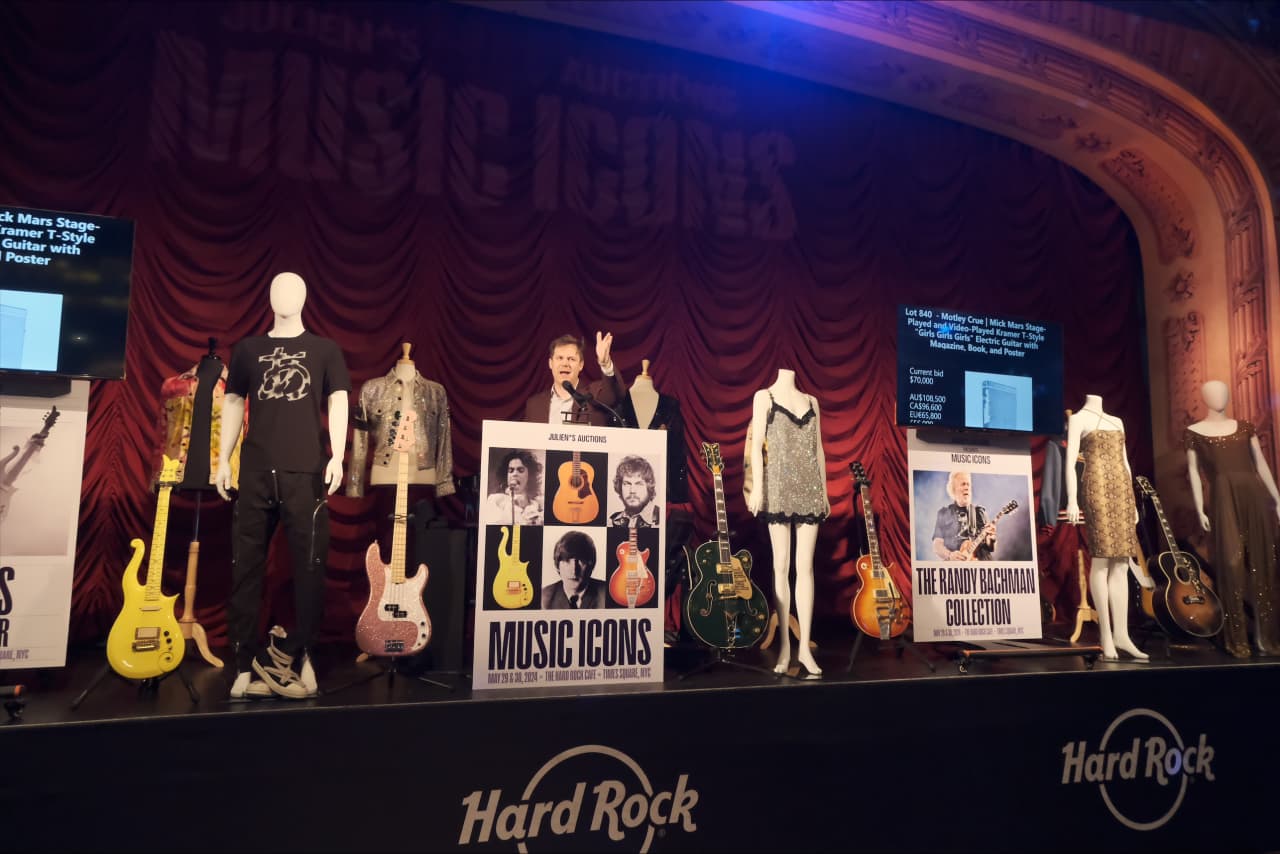From Star Trek Memorabilia to Diana’s Dresses. He’s Gavelling in the Next Generation of Auction Buyers.
A fury of fast and frequent bidding appeared to take auctioneer Kody Frederick by surprise at June sale of Princess Diana’s dresses and other memorabilia from the royal family
At one point, the bidding for a Catherine Walker evening gown worn by the late Princess of Wales blew past an original estimate of US$100,000 to US$200,000, topping out at US$450,000 with Frederick ultimately calling it “a moment of moments.”
“You have to give people a minute to breathe when you’re talking about hundreds of thousands of dollars per bid,” he says about the auction.
That event continued to rack up records, including the US$910,000 sale of another dress, and it demonstrated not only a rise in the relevance of cultural memorabilia as a category, but Frederick’s quick ascent among auctioneers.
Although on the younger side of the current auctioneer crop, at age 40, and with just two years of experience with gavel in hand, Frederick is finding himself running sales in new categories and welcoming in a new set of auction buyers.
“So much of this stuff has never come to auction, so it really is a first time [opportunity],” he says.
Frederick, who is based in Los Angeles, is not a career showperson. Prior to attending auctioneering school in Indiana, he was working in production for Disney+, and didn’t even have auctioneering on his radar until a colleague suggested he check out the profession while looking for work. He joined Julien’s in April 2020.
“My start date was supposed to be the day California went into lockdown, but it was delayed a month because of that,” he says.
Frederick ran his first auction in September 2021, selling low-value music memorabilia in a largely empty room where the top-selling item (a commemorative guitar) went for US$2,880.
“Ninety percent of our bidding takes place online, so being able to communicate to online bidders in the moment is always the challenge,” he says. “Creating the sense of excitement is challenging, and the personality is more important than the medium.”
He would continue to work his way up through various Julien’s sales until he found himself selling a signed Banksy painting in March 2023. The item was the marquee lot of a larger contemporary art sale, and had an original estimate of US$600,000 to US$800,000. The hammer price topped out at just over US$2 million.
“We had bidders in the room and put an event around it,” he says.
Frederick says it’s important to see in the room who’s bidding and in which order the bids are coming in, especially in high-value, high-volume sales.

Courtesy of Julien’s Auctions
“I have to keep things as close to real time as possible, and make sure there’s no disconnect between bidding and the auctioneer,” he says.
Much of what Julien’s sells falls into new or emerging auction categories—music memorabilia, pop culture artefacts, or modern art pieces that newer buyers connect to in ways that traditional areas (like classic art or wine) don’t.
Frederick will run an auction this fall featuring original Star Trek items and a separate event selling a significant guitar played in 1993 by the late Eddie Van Halen. Both sales could potentially resonate with those who haven’t spent much time in the auction world.
“It’s easier to convey value when an item has strong cultural significance,” he says. “A lot of what we sell has stories.”
 Copyright 2020, Dow Jones & Company, Inc. All Rights Reserved Worldwide. LEARN MORE
Copyright 2020, Dow Jones & Company, Inc. All Rights Reserved Worldwide. LEARN MORE
A divide has opened in the tech job market between those with artificial-intelligence skills and everyone else.
A 30-metre masterpiece unveiled in Monaco brings Lamborghini’s supercar drama to the high seas, powered by 7,600 horsepower and unmistakable Italian design.
A divide has opened in the tech job market between those with artificial-intelligence skills and everyone else.
There has rarely, if ever, been so much tech talent available in the job market. Yet many tech companies say good help is hard to find.
What gives?
U.S. colleges more than doubled the number of computer-science degrees awarded from 2013 to 2022, according to federal data. Then came round after round of layoffs at Google, Meta, Amazon, and others.
The Bureau of Labor Statistics predicts businesses will employ 6% fewer computer programmers in 2034 than they did last year.
All of this should, in theory, mean there is an ample supply of eager, capable engineers ready for hire.
But in their feverish pursuit of artificial-intelligence supremacy, employers say there aren’t enough people with the most in-demand skills. The few perceived as AI savants can command multimillion-dollar pay packages. On a second tier of AI savvy, workers can rake in close to $1 million a year .
Landing a job is tough for most everyone else.
Frustrated job seekers contend businesses could expand the AI talent pipeline with a little imagination. The argument is companies should accept that relatively few people have AI-specific experience because the technology is so new. They ought to focus on identifying candidates with transferable skills and let those people learn on the job.
Often, though, companies seem to hold out for dream candidates with deep backgrounds in machine learning. Many AI-related roles go unfilled for weeks or months—or get taken off job boards only to be reposted soon after.
Playing a different game
It is difficult to define what makes an AI all-star, but I’m sorry to report that it’s probably not whatever you’re doing.
Maybe you’re learning how to work more efficiently with the aid of ChatGPT and its robotic brethren. Perhaps you’re taking one of those innumerable AI certificate courses.
You might as well be playing pickup basketball at your local YMCA in hopes of being signed by the Los Angeles Lakers. The AI minds that companies truly covet are almost as rare as professional athletes.
“We’re talking about hundreds of people in the world, at the most,” says Cristóbal Valenzuela, chief executive of Runway, which makes AI image and video tools.
He describes it like this: Picture an AI model as a machine with 1,000 dials. The goal is to train the machine to detect patterns and predict outcomes. To do this, you have to feed it reams of data and know which dials to adjust—and by how much.
The universe of people with the right touch is confined to those with uncanny intuition, genius-level smarts or the foresight (possibly luck) to go into AI many years ago, before it was all the rage.
As a venture-backed startup with about 120 employees, Runway doesn’t necessarily vie with Silicon Valley giants for the AI job market’s version of LeBron James. But when I spoke with Valenzuela recently, his company was advertising base salaries of up to $440,000 for an engineering manager and $490,000 for a director of machine learning.
A job listing like one of these might attract 2,000 applicants in a week, Valenzuela says, and there is a decent chance he won’t pick any of them. A lot of people who claim to be AI literate merely produce “workslop”—generic, low-quality material. He spends a lot of time reading academic journals and browsing GitHub portfolios, and recruiting people whose work impresses him.
In addition to an uncommon skill set, companies trying to win in the hypercompetitive AI arena are scouting for commitment bordering on fanaticism .
Daniel Park is seeking three new members for his nine-person startup. He says he will wait a year or longer if that’s what it takes to fill roles with advertised base salaries of up to $500,000.
He’s looking for “prodigies” willing to work seven days a week. Much of the team lives together in a six-bedroom house in San Francisco.
If this sounds like a lonely existence, Park’s team members may be able to solve their own problem. His company, Pickle, aims to develop personalised AI companions akin to Tony Stark’s Jarvis in “Iron Man.”
Overlooked
James Strawn wasn’t an AI early adopter, and the father of two teenagers doesn’t want to sacrifice his personal life for a job. He is beginning to wonder whether there is still a place for people like him in the tech sector.
He was laid off over the summer after 25 years at Adobe , where he was a senior software quality-assurance engineer. Strawn, 55, started as a contractor and recalls his hiring as a leap of faith by the company.
He had been an artist and graphic designer. The managers who interviewed him figured he could use that background to help make Illustrator and other Adobe software more user-friendly.
Looking for work now, he doesn’t see the same willingness by companies to take a chance on someone whose résumé isn’t a perfect match to the job description. He’s had one interview since his layoff.
“I always thought my years of experience at a high-profile company would at least be enough to get me interviews where I could explain how I could contribute,” says Strawn, who is taking foundational AI courses. “It’s just not like that.”
The trouble for people starting out in AI—whether recent grads or job switchers like Strawn—is that companies see them as a dime a dozen.
“There’s this AI arms race, and the fact of the matter is entry-level people aren’t going to help you win it,” says Matt Massucci, CEO of the tech recruiting firm Hirewell. “There’s this concept of the 10x engineer—the one engineer who can do the work of 10. That’s what companies are really leaning into and paying for.”
He adds that companies can automate some low-level engineering tasks, which frees up more money to throw at high-end talent.
It’s a dynamic that creates a few handsomely paid haves and a lot more have-nots.
From Italy’s $93,000-a-night villas to a $20,000 Bowral château, a new global ranking showcases the priciest Airbnbs available in 2026.
Ophora Tallawong has launched its final release of quality apartments priced under $700,000.























